License Plate Recognition (LPR)
Subject to license
The G-Tect LPR (license plate recognition) is used for number plates recognition, including US and Australian number plates.
G-Tect LPR consists of a LPR service, which integrates the LPR SDK (delivers the algorithm for the number plate recognition) and a parametrization page in G-Set as well as the VCA Setup Editor.
Requirements
For installing and using G-Tect/LPR, the LPR dongle (verifies and regulates the LPR licensing) and an installation of G-Core together with the respective G-Core option for LPR are necessary.
The G-Tect/LPR licensing is carried out per each channel.
Installation
The G-Tect/LPR is not installed automatically using G-Core, but using a separate G-Tect/LPR installer.
At the beginning of the installation, there are three options to choose from:
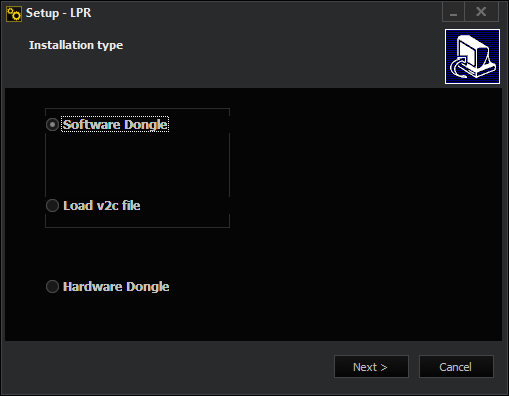
|
Installation Type |
Description |
|---|---|
|
Software Dongle |
During the installation of the software dongle, the LPR and haspdinst.exe are installed. At the end of the installation, a c2v file is generated and needs to be sent to anpr@geutebrueck.com. gesendet werden muss. After sending, a v2c file is returned from Geutebrück. |
|
Hardware Dongle |
During the hardware dongle installation, the LPR and the Marx dongle is installed. Therefore the LPR Marx dongle is necessary. |
|
Load v2c file |
Here, the user can view returned v2c files to license the LPR's software dongle version. |
After the installation process has been successfully completed, the CBIOS or the Secure Sentinel and the G-Tect LPR Service is started.
Configuration
The LPR is configured in two different locations:
- Using the VCA Setup Editor a local connection of the G-Tect LPR Services is set up on the analysis host to one or more G-Core servers.
- Using the parametrization page in G-Set, the exact parameters for the analysis are to be generated.
Configuration of Parameters in G-Set
Via the parametrization page LPR in G-Set some basic settings must be made in the first place.
Therefor, a connection to the G-Core server is to be established:
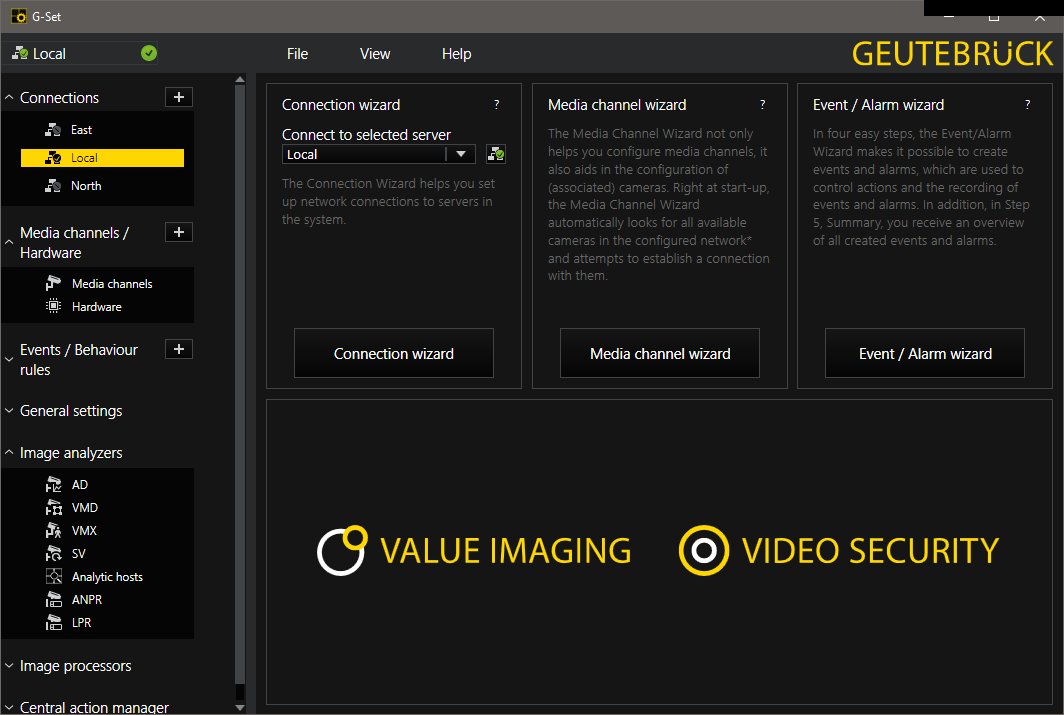
When a connection to server was established, the page LPR can be found under Image Analyzers.
At the top of this page, there is a switch that displays whether later during the analysis for backwards compatibility the LPR Setup Editor's settings are used or whether the settings made in G-Set are used. If the switch is disabled, the settings made in G-Set are used. Those are saved to the G-Core Registry.
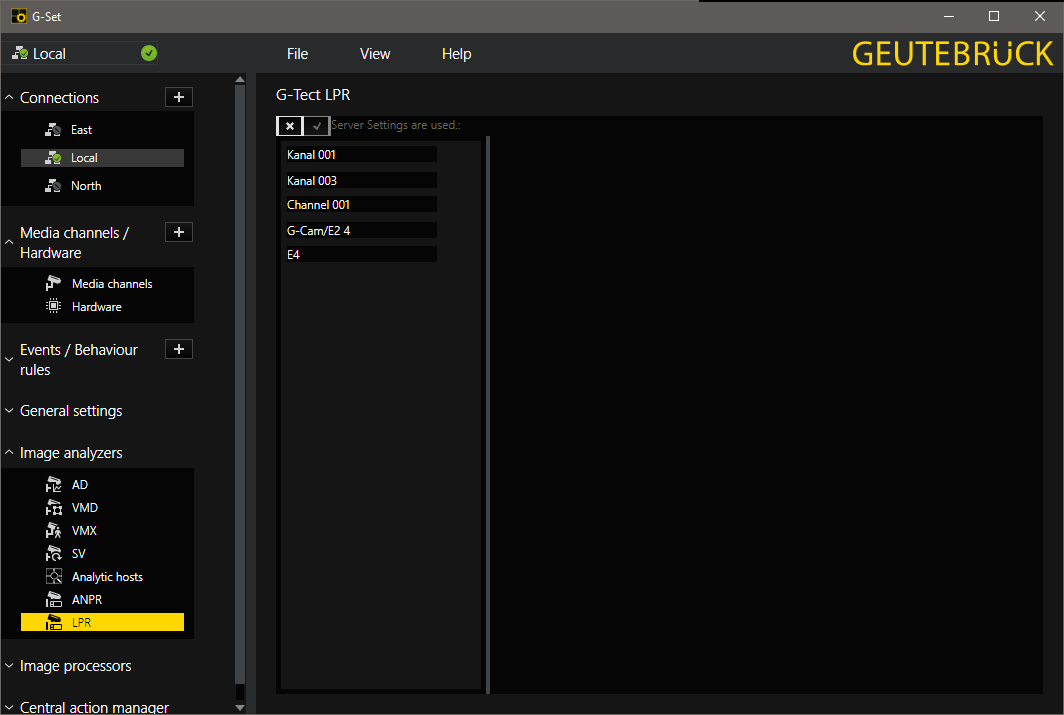
Settings can be set for each media channel individually.
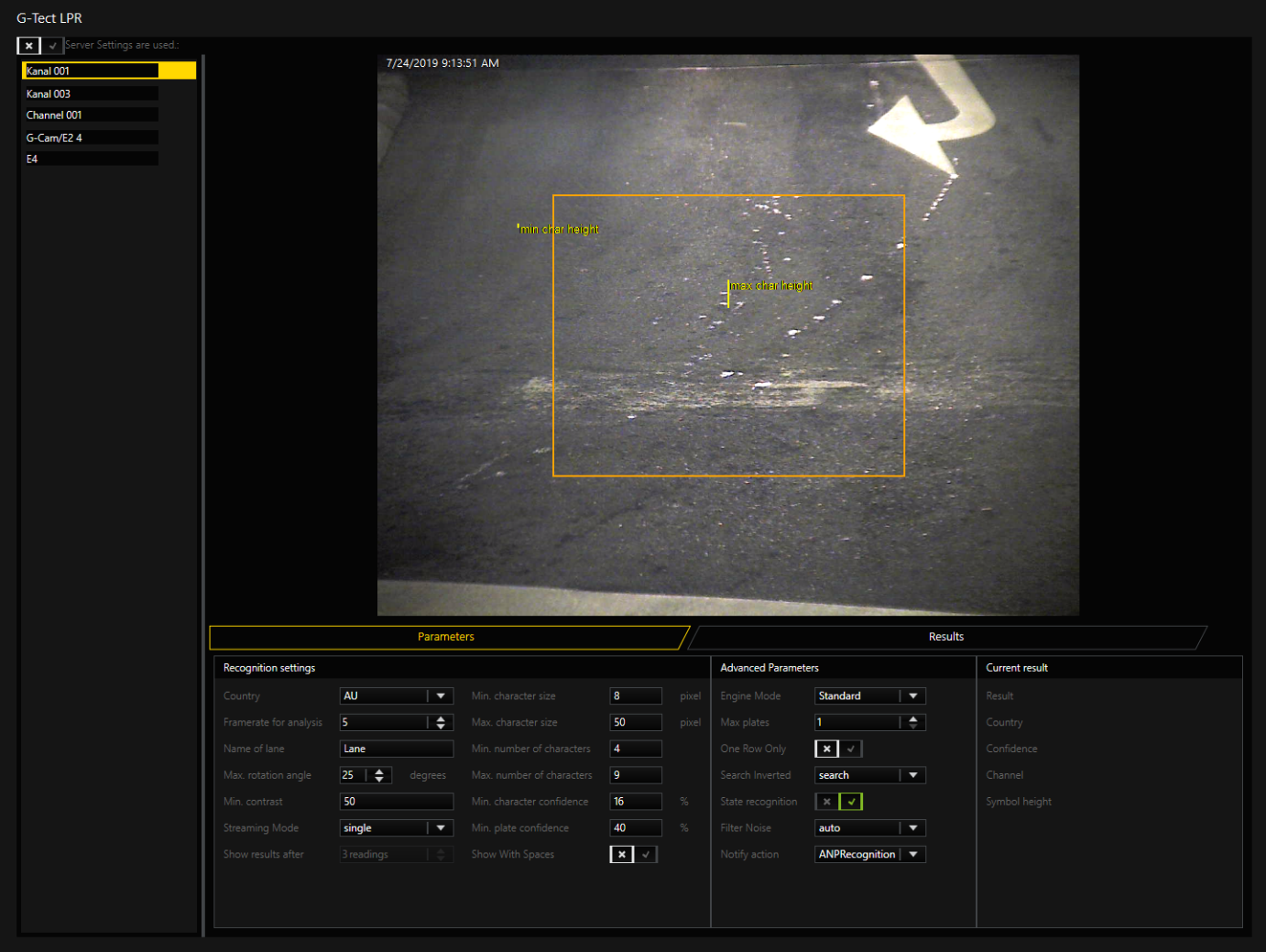
In the Parameter tab, various settings can be made:
|
Parameter |
Description |
Default value |
|---|---|---|
|
Country1 |
Determines the country template used for the number plate registration |
- |
|
Framerate for analysis |
Determines how many images should be analyzed |
every fifth image |
|
Name of lane |
Determines the name of the displayed lane (e.g. entry/exit) |
- |
|
Max. rotation angle |
Determines the maximum rotation of a number plate in the image |
25 |
|
Min. Contrast |
Determines the contrast between letter and background of the number plate |
|
|
Streaming Mode |
Can be selected to set several predefined settings for the processing of the images (values: single, parking, offline, freeflow) |
single |
|
Show results after x readings |
Determines after how many consecutive registrations of the same number palte, the LPR Service should display results. |
- |
|
Min. character size |
Determines the minimum height of a character on a number plate |
8 |
|
Max. character size |
Determines the maximum height of a character on a number plate |
50 |
|
Min. number of characters |
Determines the minimum amount of the characters on the number plate |
4 |
|
Max. number of characters |
Determines the maximum amount of the characters on the number plate |
9 |
|
Min. character confidence |
Determines at which security per character the LPR Service should deliver a result |
16 |
|
Min. plate confidence |
Determines at which security per number plate the LPR Service should deliver a result |
40 |
|
Show with Spaces |
The result contains the number plate correctly formatted with spaces |
false |
|
Engine mode |
Determines in which performance mode the LPR service should operate (options: best, high, standarf, fast or fastest) |
Standard |
|
MaxPlates |
Determines the maximum amount of number plates being returned as a result per each image |
1 |
|
One Row Only |
If activated, number plates with more than one row are ignored |
false |
|
Search Inverted |
Determines if the system should search for inverted number plates (white on black). Search searches for such number plates in case no usual ones can be found (Values: none, search, always) |
none |
|
State Recognition |
If the number plate's country of origin should be recognized automatically |
true |
|
Filter Noise |
Determines if the noise in an image should be filtered out (Values: on, off, auto) |
auto |
|
Notify action |
Which action should be sent: |
ANPRRecognition |
1 The available countries are read from the classifiers' prefixes in the directory C:\ProgramData\Gng\LPR\data.
Another parameter , the "„ROI" (= region of interest) indicating in which area of the image number plates are to be found and analyzed, can be customized by holding the left mouse button and then dragging the mouse over the viewer. The ROI is displayed in an orange color within the viewer. Furthermore, the parameters Min. and Max. character size are displayed in yellow within the viewer.
To save changes, the setup has to be sent to the server (Send Config to Server). The data is saved to C:\ProgramData\Gng\LPR\GTectLPR.xml) as an XML file.
Hidden Parameters
There is a hidden parameter that is not editable via the LPR dialog in G-Set. It does not exist by default and will not be created automatically by G-Core at any point. It needs to be created manually in the G-Core Registry. As long as the key in the G-Core Registry is not created, the service operates with the default value.
|
Parameter |
Function |
Default Value |
|---|---|---|
|
MinTimeBetweenRetrigger (System -> Global Settings -> MinTimeBetweenRetrigger; Int 32) |
Indicates for how many seconds a certain license plate will be ignored if no other license plate is recognized in the meantime . After the expiration of this time period, the license plate will be recognized again. The setting "0" is interpreted as infinite, which means that another license plate needs to be recognized before another action can be sent to a recognized incense plate. This corresponds to the former behavior of the service. |
30 |
Country Classifier
The following classifiers are installed along and should exist in the directory C:\ProgramData\Gng\LPR\data before running G-Set or the LPR Service.
If this is not the case, an analysis will not be performed.
|
Initials/File name |
Meaning |
Supports State Recognition |
|---|---|---|
|
AU |
Australia |
Yes |
|
AE |
United Arab Emirates |
Yes |
|
BN |
Nation of Brunei, the Abode of Peace |
No |
|
EU |
Europe |
Yes |
|
HK |
Hong Kong |
No |
|
IN |
India |
No |
|
MY |
Malaysia |
No |
|
NZ |
New Zealand |
No |
|
PE |
Peru |
No |
|
PH |
Philippines |
No |
|
USA |
United States |
Yes |
Turn On/Off Analysis in VCA Setup Editor
In G-Set only parameters for the analysis are set. However, switching on/off the individual channels can be done in the VCA Setup Editor.
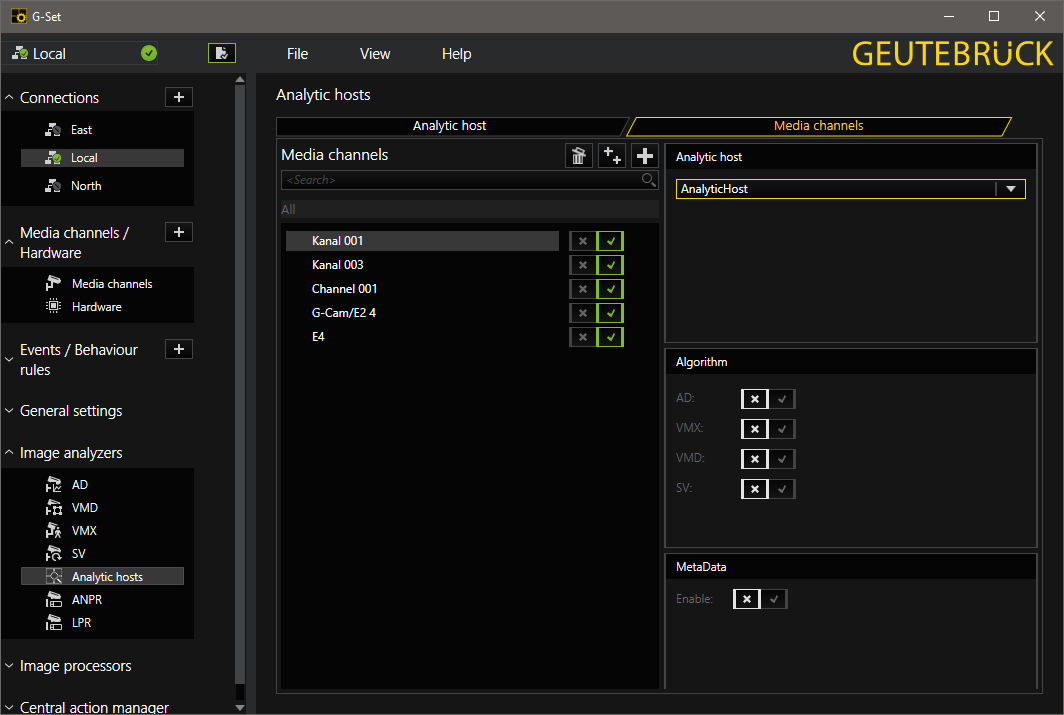
IMPORTANT: The VCA Setup Editor has to be run locally on the device designated to run the G-Tect LPR service, not depending on where the G-Core server is running.
The VCA Setup Editor is storing to which G-Core servers the G-Tect LPR service should connect to and which channels should get analyzed. On the screen shot, the service would connect to the local G-Core server and analyze the channel Kanal 001.
The settings are saved to the Windows Registry under the key Computer\HKEY_LOCAL_MACHINE\SOFTWARE\Geutebrueck\VCA\Connections\ :
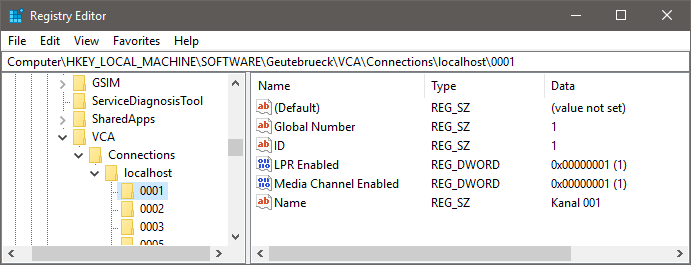
Functioning and Data Exchange
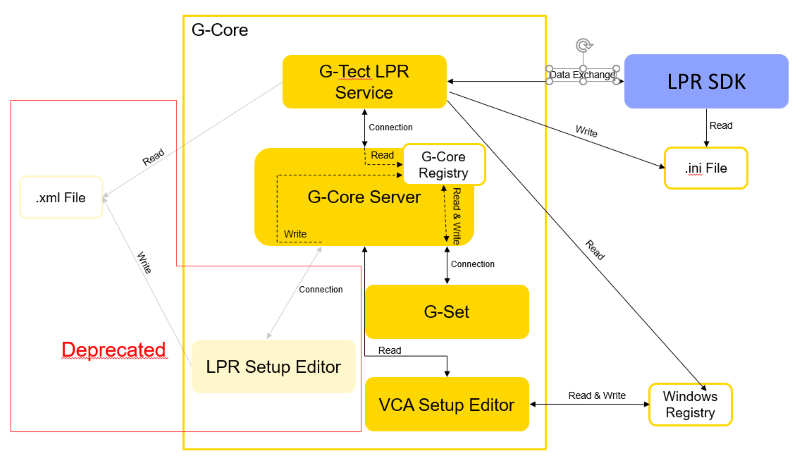
The G-Tect LPR is part of G-Core. However, the software is independent from the G-Core server and can run on a separate device. The LPR service as well as G-Set and the VCA Setup Editor establish a connection to the G-Core server.
G-Set saves the analysis parameters to the G-Core Registry. The VCA Setup Editor saves information about the activated channel to the Windows Registry, which are read from the LPR service. The LPR service connects to the server specified in the Windows Registry and instantiates the LPR SDK.
To this LPR SDK the LPR service delivers parameters for the analysis in an *.ini filem which are stored in the directory C:\ProgramData\Gng\LPR\data\. It reads out the parameters from the G-Core registry. Next, the LPR service and the LPR SDK exchange data to handover the images to the analysis and to get the identified number plates.
When the algorithm recognized a number plate, it sends an action to the LPR service. The LPRSetup responds and displays the results under Current result or in the Results tab.
With each change of the G-Core registry the LPR service is notified and the channels are initialized anew, meaning that the *.ini file is rewritten and the SDK is notified.
As a fallback the server searches for the *.xml file of the LPR Setup Editor and uses the parameters included for initializing the SDK.
LPR Direction Filter

In the Direction Filter tab number plates, that move into image form certain directions, can be excluded . Added directional filters must be activated via the slider.
Two additional sliders are implemented for the exact configurations:
|
Configuration |
Description |
|---|---|
|
Angle |
With the angle slider the direction of the angle can be configured. |
|
Variance |
The Variance slider determines the size of the angle. |
For tab parameter the streaming mode must be different from "single" to activate the recognition of the number plates.
The Preview chart represents the set direction filter. In red are the excluded license plates that move form the center to the outside of the camera image. Accordingly, number plates that are recognized and forwarded by G-Tec/LPR are shown in green. To realize more complex analysis situations it is possible to implement several direction filters. Usually, one filter should be sufficient to solve classical entry and exit scenarios. Only unfiltered license plates generate actions that can be displayed and understood afterwards.
Results View
In the Parameter tab as well as in the Results tab, the most recent reading result (of the currently switched channel) is displayed at the lower right-hand edge. The data contain:
- the reading result (e.g. XXYY123)
- the country the number plate was assigned to (e.g. DE),
- the security information about the recognized number plate (e.g. 92 %)
- the channel on which the number plate was recognized
- the size of the characters on the number plate
These data is registered together with a timestamp in the table in the Results tab.
The table displays all the results delivered from the LPR service but can also be filtered by the currently switched channel or sorted by the table columns. All results are temporary saved in the Results table and are discarded when G-Set or the LPR Setup Editor is closed.
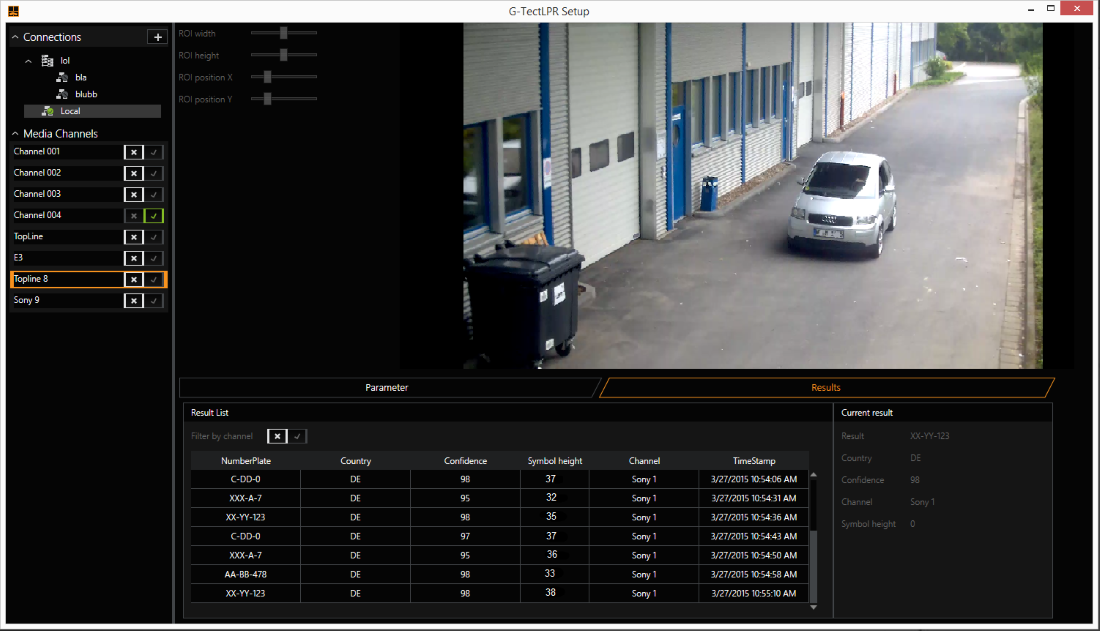
LPR Setup Editor
The LPR Setup Editor is outdated and is replaced by the configuration interface in G-Set.
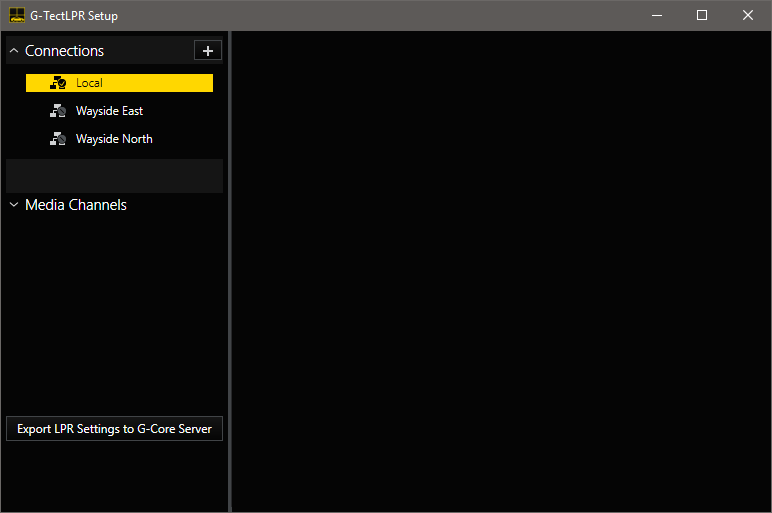
To guarantee existing installations a transition the LPR Setup Editor offers the possibility to transmit its settings to the respective G-Core server:
1. In the LPR Setup Editor, establish a connection to the G-Core Server.
2. To transfer the settings individually to each server, click Export LPR Settings to G-Core Server.
IMPORTANT: Since the LPR Setup Editor muste be able to save settings, it connects to the G-Core server with the same privileges as G-Set. Consequently, it is not possible for the LPR Setup Editor to connect to the C-Core server when G-Set is already connected, and vice versa,
The *.xml file, in which the LPR Setup Editor's settings are saved, will remain to prevent settings from getting lost.
In G-Set, it is possible to determine via a switch whether the G-Tect LPR service should read out the data from the registry or if it should continue using the *.xml file enabling to go back to the former configuration again. Furthermore, in case no data can be found in the registry or in case the data is incorrect, the service as a fallback tries to read out data from the *.xml file in order to initialize the SDK . However, it is not possible to generate a new *.xml file from the new configuration using G-Set.
The LPR Setup Editor is to be removed with the upcoming release. Thus, it should not be used anymore. Instead, the settings in G-Set should be used.